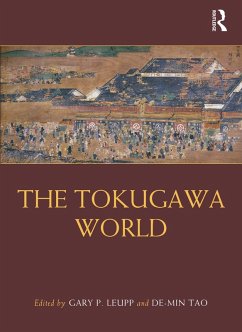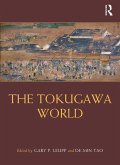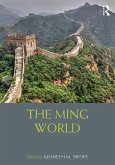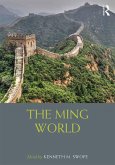The Tokugawa World (eBook, ePUB)
Redaktion: Leupp, Gary P.; Tao, De-min
49,95 €
49,95 €
inkl. MwSt.
Sofort per Download lieferbar

25 °P sammeln
49,95 €
Als Download kaufen

49,95 €
inkl. MwSt.
Sofort per Download lieferbar

25 °P sammeln
Jetzt verschenken
Alle Infos zum eBook verschenken
49,95 €
inkl. MwSt.
Sofort per Download lieferbar
Alle Infos zum eBook verschenken

25 °P sammeln
The Tokugawa World (eBook, ePUB)
Redaktion: Leupp, Gary P.; Tao, De-min
- Format: ePub
- Merkliste
- Auf die Merkliste
- Bewerten Bewerten
- Teilen
- Produkt teilen
- Produkterinnerung
- Produkterinnerung

Bitte loggen Sie sich zunächst in Ihr Kundenkonto ein oder registrieren Sie sich bei
bücher.de, um das eBook-Abo tolino select nutzen zu können.
Hier können Sie sich einloggen
Hier können Sie sich einloggen
Sie sind bereits eingeloggt. Klicken Sie auf 2. tolino select Abo, um fortzufahren.

Bitte loggen Sie sich zunächst in Ihr Kundenkonto ein oder registrieren Sie sich bei bücher.de, um das eBook-Abo tolino select nutzen zu können.
With over 60 contributions, The Tokugawa World presents the latest scholarship on early modern Japan from an international team of specialists in a volume that is unmatched in its breadth and scope.
- Geräte: eReader
- mit Kopierschutz
- eBook Hilfe
Andere Kunden interessierten sich auch für
![The Tokugawa World (eBook, PDF) The Tokugawa World (eBook, PDF)]() The Tokugawa World (eBook, PDF)49,95 €
The Tokugawa World (eBook, PDF)49,95 €![The Ming World (eBook, ePUB) The Ming World (eBook, ePUB)]() The Ming World (eBook, ePUB)49,95 €
The Ming World (eBook, ePUB)49,95 €![A History of the Islamic World, 600-1800 (eBook, ePUB) A History of the Islamic World, 600-1800 (eBook, ePUB)]() Jo van SteenbergenA History of the Islamic World, 600-1800 (eBook, ePUB)40,95 €
Jo van SteenbergenA History of the Islamic World, 600-1800 (eBook, ePUB)40,95 €![The Ming World (eBook, PDF) The Ming World (eBook, PDF)]() The Ming World (eBook, PDF)49,95 €
The Ming World (eBook, PDF)49,95 €![A History of the Islamic World, 600-1800 (eBook, PDF) A History of the Islamic World, 600-1800 (eBook, PDF)]() Jo van SteenbergenA History of the Islamic World, 600-1800 (eBook, PDF)40,95 €
Jo van SteenbergenA History of the Islamic World, 600-1800 (eBook, PDF)40,95 €![Life After Death Today in the United States, Japan, and China (eBook, ePUB) Life After Death Today in the United States, Japan, and China (eBook, ePUB)]() Gordon MathewsLife After Death Today in the United States, Japan, and China (eBook, ePUB)39,95 €
Gordon MathewsLife After Death Today in the United States, Japan, and China (eBook, ePUB)39,95 €![1900 or The Last President (eBook, ePUB) 1900 or The Last President (eBook, ePUB)]() Ingersoll Lockwood1900 or The Last President (eBook, ePUB)1,49 €
Ingersoll Lockwood1900 or The Last President (eBook, ePUB)1,49 €-
-
-
With over 60 contributions, The Tokugawa World presents the latest scholarship on early modern Japan from an international team of specialists in a volume that is unmatched in its breadth and scope.
Dieser Download kann aus rechtlichen Gründen nur mit Rechnungsadresse in A, B, BG, CY, CZ, D, DK, EW, E, FIN, F, GR, HR, H, IRL, I, LT, L, LR, M, NL, PL, P, R, S, SLO, SK ausgeliefert werden.
Produktdetails
- Produktdetails
- Verlag: Taylor & Francis eBooks
- Seitenzahl: 1198
- Erscheinungstermin: 20. September 2021
- Englisch
- ISBN-13: 9781000427417
- Artikelnr.: 62471695
- Verlag: Taylor & Francis eBooks
- Seitenzahl: 1198
- Erscheinungstermin: 20. September 2021
- Englisch
- ISBN-13: 9781000427417
- Artikelnr.: 62471695
- Herstellerkennzeichnung Die Herstellerinformationen sind derzeit nicht verfügbar.
Gary P. Leupp is Professor of History, Tufts University, author of Servants, Shophands and Laborers in the Cities of Tokugawa Japan (1989); Male Colors: The Construction of Homosexuality in Tokugawa Japan (1993); Interracial Intimacy: Japanese Women and Western Men, 1543-1900 (2001), and other works on class, gender, and ethnicity in Japanese history.
De-min Tao is Professor Emeritus at Kansai University, Japan, author of A Study of the Kaitokud Neo-Confucianism (J. 1994); Yoshida Sh in and Commodore Perry: A Multilingual Study of the 1854 Shimoda Incident (2020); and An Alternative Image of Nait Konan: 20 Years of Research about the Nait Collection at Kansai University Library (J. 2021).
De-min Tao is Professor Emeritus at Kansai University, Japan, author of A Study of the Kaitokud Neo-Confucianism (J. 1994); Yoshida Sh in and Commodore Perry: A Multilingual Study of the 1854 Shimoda Incident (2020); and An Alternative Image of Nait Konan: 20 Years of Research about the Nait Collection at Kansai University Library (J. 2021).
Introduction
Part I: National Reunification, 1563-1603
1. The Three Unifiers of the Empire (Tenka): Nobunaga (1534-82), Hideyoshi (1536-98) and Ieyasu (1543-1616)
Fujita Tatsuo
2. Japan's Invasions of Korea in 1592-98 and the Hideyoshi Regime
Nam-Lin Hur
3. The Life and Afterlife of Tokugawa Ieyasu (1543-1616)
Morgan Pitelka
Part II: The Physical Landscape
4. Water Management in Tokugawa Japan
Murata Michihito
5. The King Yu Legend and Flood Control in Tokugawa Japan
Wang Min
6. Earthquakes in Historical Context
Gregory Smits
7. The Centre of the Shogun's Realm: Building Nihonbashi
Timon Screech
Part III: Tokugawa Society
8. The Samurai in Tokugawa Japan
Constantine Vaporis
9. Villages and Farmers in the Tokugawa Period
Watanabe Takashi
10. Popular Movements in the Edo Period: Peasants, Peasant Uprisings, and the Development of Lawful Petitions
Taniyama Masamichi
11. Coastal Whaling and Its Impact on Early Modern Japan
Jakobina Arch
12. Outcastes and Their Social Roles in Tokugawa Japan
Maren Ehlers
Part IV: Family, Gender, Sexuality and Reproduction
13. Women in Cities and Towns
Amy Stanley
14. Childhood in Tokugawa Japan
Kristin Williams
15. Growing Small Bodies at the Point of Skin: Young Children's Bodies and Health in Sacred Skinscape
William Lindsey
Part V: Tokugawa Economy
16. Food Fights, But It's Always for Fun in Early Modern Japan
Eric Rath
17. The Silk Weavers of Nishijin: Wage-Laborers in the Tokugawa World
Gary P. Leupp
18. The Marketing of Human Waste and Urban-fringe Agriculture around the Tokugawa Cities
Tajima Kayo
Part VI: Tokugawa Japan in the World
19. Japan and the World in Tokugawa Maps
Kären Wigen
20. Nihonmachi in Southeast Asia in the Late Sixteenth-Early Seventeenth Centuries
Travis Seifman
21. Rethinking Ezo-chi, the Ainu, and Tokugawa Japan in Global Perspective
Noémy Godefroy
22. The Opening of the Tokugawa World and Japan's Foreign Relations: The Visits of Korean Embassies to Japan
Nakao Hiroshi
23. Early Modern Ryukyu Between China and Japan
Watanabe Miki
24. Dutch East India Company Relations With Tokugawa Japan
Adam Clulow
25. The Presence of Black People in Japan During the Edo Perio
Fujita Midori
26. Seventeenth Century Chinese Émigrés and Sino-Japanese Cultural Exchanges
Shyu Shing-ching
27. Selective Sakoku? Tantalizing Hints of Japanese in China after the Tokugawa Maritime Prohibition
Xing Hang
28. Tokugawa Japan and the Rise of Modern Racial Thought in the West
Rotem Kowner
Part VII: The Performing Arts and Sport
29. The Musical World of Tokugawa Japan
Alison Tokita
30. Visual Disability and Musical Culture in Edo-Period Japan
Gerald Groemer
31. Tominaga Nakamoto (1715-1746) and Gagaku (Court Music)
Int Kazuhiro
32. Staging Senseless Violence: Early J ruri Puppet Theater and the Culture of Performance
Keller Kimbrough
33. Rural Kabuki and the Imagination of Japanese Identity in the Late Tokugawa Period
William Fleming
34. Sumo Wrestling in the Tokugawa Period
Lee Thompson
Part VIII: Art and Literature
35. Shunga in Tokugawa Society and Culture
Andrew Gerstle
36. Uses of Shunga and Ukiyoe in the Tokugawa Period
Hayakawa Monta
37. Two Paths of Love in the Fiction of Ihara Saikaku
David Gundry
38. Furuta Oribe: Controversial Daimyo Tea Master
Kaminishi Ikumi
39. Grass Booklets and the Roots of Manga: Comic Books in the Tokugawa Period
Glynne Walley
40. An Iconology of the Orchid Pavilion Gathering: Image, Text, and Communities in Tokugawa-Era Japan
Kameda-Madar Kazuko
41. The Folk Worldview of Chronicles of the Eight Dog Heroes of the Satomi Clan of Nans
Inoue Atsushi
42. Okakura Kakuz and the Osaka Painting Schools of the Tokugawa Era
Nakatani Nobuo
43. The Rise and Fall and Spring of Haiku
Adam L. Kern
Part IX: Religion and Thought
44. Christians, Christianity and Kakure Kirishitan in Japan (1549-1868)
Jan Leuchtenberger
45. Pilgrimage in Tokugawa Japan
Barbara Ambros
46. Structuring the Canon: Exceptionalism and Kokugaku
Mark McNally
47. The Image of Susanoo in Hirata Atsutane's Koshiden
Tajiri Yuichir
48. It Jinsai and the Origins of Classical Learning (Kogaku)
Tsuchida Kenjir
49. Mapping Intellectual History: The Neo-Confucian Schools of Zhu Xi, Wang Yangming, and Ogyu Sorai as Mirrored in Islamic Thought
Kojima Yasunori
50. Emperor-Centrism and the Historiography of the Mito School
Kojima Tsuyoshi
51. Heigaku and Bushid : Military Thought in the Tokugawa World
Maeda Tsutomu
52. Confucian Views of Life and Death
Takahashi Fumihiro
Part X: Education and Science
53. Tokugawa Popular Education
Brian Platt
54. The Greater Learning for Women and Women's Moral Education in Tokugawa Japan
Yabuta Yutaka
55. "Reading" of the Chinese Classics and the History of Thought in the Edo Period
Nakamura Shunsaku
56. Health, Disease and Epidemics in Late Tokugawa Japan
William Johnston
57. Doctors and Herbal Medicine in Tokugawa Japan
Machi Sunjur
58. The History of Natural History in Tokugawa Japan
Federico Marcon
59. Attitudes Toward Celestial Events in Tokugawa Japan
Sugi Takeshi
Part XI: Epilogue
60. From Feudalism to Meritocracy?: Growing Demand for Competent and Efficient Government in the Late Tokugawa Period
Matsuda Koichir
61. Sh in and Changing Worldviews in the Late Tokugawa Period
Kirihara Kenshin
62. The Shinsengumi: Shadows and Light in the Last Days of the Tokugawa Shogunate
Kimura Yukihiko
63. Katsu Kaishu and Yokoi Sh nan: Late Tokugawa Imaginings of a More Democratic Japan
William Steele
64. Confucian Education in the Formative Years of the Meiji Leaders and Its Modern Implications
De-min Tao
Part I: National Reunification, 1563-1603
1. The Three Unifiers of the Empire (Tenka): Nobunaga (1534-82), Hideyoshi (1536-98) and Ieyasu (1543-1616)
Fujita Tatsuo
2. Japan's Invasions of Korea in 1592-98 and the Hideyoshi Regime
Nam-Lin Hur
3. The Life and Afterlife of Tokugawa Ieyasu (1543-1616)
Morgan Pitelka
Part II: The Physical Landscape
4. Water Management in Tokugawa Japan
Murata Michihito
5. The King Yu Legend and Flood Control in Tokugawa Japan
Wang Min
6. Earthquakes in Historical Context
Gregory Smits
7. The Centre of the Shogun's Realm: Building Nihonbashi
Timon Screech
Part III: Tokugawa Society
8. The Samurai in Tokugawa Japan
Constantine Vaporis
9. Villages and Farmers in the Tokugawa Period
Watanabe Takashi
10. Popular Movements in the Edo Period: Peasants, Peasant Uprisings, and the Development of Lawful Petitions
Taniyama Masamichi
11. Coastal Whaling and Its Impact on Early Modern Japan
Jakobina Arch
12. Outcastes and Their Social Roles in Tokugawa Japan
Maren Ehlers
Part IV: Family, Gender, Sexuality and Reproduction
13. Women in Cities and Towns
Amy Stanley
14. Childhood in Tokugawa Japan
Kristin Williams
15. Growing Small Bodies at the Point of Skin: Young Children's Bodies and Health in Sacred Skinscape
William Lindsey
Part V: Tokugawa Economy
16. Food Fights, But It's Always for Fun in Early Modern Japan
Eric Rath
17. The Silk Weavers of Nishijin: Wage-Laborers in the Tokugawa World
Gary P. Leupp
18. The Marketing of Human Waste and Urban-fringe Agriculture around the Tokugawa Cities
Tajima Kayo
Part VI: Tokugawa Japan in the World
19. Japan and the World in Tokugawa Maps
Kären Wigen
20. Nihonmachi in Southeast Asia in the Late Sixteenth-Early Seventeenth Centuries
Travis Seifman
21. Rethinking Ezo-chi, the Ainu, and Tokugawa Japan in Global Perspective
Noémy Godefroy
22. The Opening of the Tokugawa World and Japan's Foreign Relations: The Visits of Korean Embassies to Japan
Nakao Hiroshi
23. Early Modern Ryukyu Between China and Japan
Watanabe Miki
24. Dutch East India Company Relations With Tokugawa Japan
Adam Clulow
25. The Presence of Black People in Japan During the Edo Perio
Fujita Midori
26. Seventeenth Century Chinese Émigrés and Sino-Japanese Cultural Exchanges
Shyu Shing-ching
27. Selective Sakoku? Tantalizing Hints of Japanese in China after the Tokugawa Maritime Prohibition
Xing Hang
28. Tokugawa Japan and the Rise of Modern Racial Thought in the West
Rotem Kowner
Part VII: The Performing Arts and Sport
29. The Musical World of Tokugawa Japan
Alison Tokita
30. Visual Disability and Musical Culture in Edo-Period Japan
Gerald Groemer
31. Tominaga Nakamoto (1715-1746) and Gagaku (Court Music)
Int Kazuhiro
32. Staging Senseless Violence: Early J ruri Puppet Theater and the Culture of Performance
Keller Kimbrough
33. Rural Kabuki and the Imagination of Japanese Identity in the Late Tokugawa Period
William Fleming
34. Sumo Wrestling in the Tokugawa Period
Lee Thompson
Part VIII: Art and Literature
35. Shunga in Tokugawa Society and Culture
Andrew Gerstle
36. Uses of Shunga and Ukiyoe in the Tokugawa Period
Hayakawa Monta
37. Two Paths of Love in the Fiction of Ihara Saikaku
David Gundry
38. Furuta Oribe: Controversial Daimyo Tea Master
Kaminishi Ikumi
39. Grass Booklets and the Roots of Manga: Comic Books in the Tokugawa Period
Glynne Walley
40. An Iconology of the Orchid Pavilion Gathering: Image, Text, and Communities in Tokugawa-Era Japan
Kameda-Madar Kazuko
41. The Folk Worldview of Chronicles of the Eight Dog Heroes of the Satomi Clan of Nans
Inoue Atsushi
42. Okakura Kakuz and the Osaka Painting Schools of the Tokugawa Era
Nakatani Nobuo
43. The Rise and Fall and Spring of Haiku
Adam L. Kern
Part IX: Religion and Thought
44. Christians, Christianity and Kakure Kirishitan in Japan (1549-1868)
Jan Leuchtenberger
45. Pilgrimage in Tokugawa Japan
Barbara Ambros
46. Structuring the Canon: Exceptionalism and Kokugaku
Mark McNally
47. The Image of Susanoo in Hirata Atsutane's Koshiden
Tajiri Yuichir
48. It Jinsai and the Origins of Classical Learning (Kogaku)
Tsuchida Kenjir
49. Mapping Intellectual History: The Neo-Confucian Schools of Zhu Xi, Wang Yangming, and Ogyu Sorai as Mirrored in Islamic Thought
Kojima Yasunori
50. Emperor-Centrism and the Historiography of the Mito School
Kojima Tsuyoshi
51. Heigaku and Bushid : Military Thought in the Tokugawa World
Maeda Tsutomu
52. Confucian Views of Life and Death
Takahashi Fumihiro
Part X: Education and Science
53. Tokugawa Popular Education
Brian Platt
54. The Greater Learning for Women and Women's Moral Education in Tokugawa Japan
Yabuta Yutaka
55. "Reading" of the Chinese Classics and the History of Thought in the Edo Period
Nakamura Shunsaku
56. Health, Disease and Epidemics in Late Tokugawa Japan
William Johnston
57. Doctors and Herbal Medicine in Tokugawa Japan
Machi Sunjur
58. The History of Natural History in Tokugawa Japan
Federico Marcon
59. Attitudes Toward Celestial Events in Tokugawa Japan
Sugi Takeshi
Part XI: Epilogue
60. From Feudalism to Meritocracy?: Growing Demand for Competent and Efficient Government in the Late Tokugawa Period
Matsuda Koichir
61. Sh in and Changing Worldviews in the Late Tokugawa Period
Kirihara Kenshin
62. The Shinsengumi: Shadows and Light in the Last Days of the Tokugawa Shogunate
Kimura Yukihiko
63. Katsu Kaishu and Yokoi Sh nan: Late Tokugawa Imaginings of a More Democratic Japan
William Steele
64. Confucian Education in the Formative Years of the Meiji Leaders and Its Modern Implications
De-min Tao
Introduction
Part I: National Reunification, 1563-1603
1. The Three Unifiers of the Empire (Tenka): Nobunaga (1534-82), Hideyoshi (1536-98) and Ieyasu (1543-1616)
Fujita Tatsuo
2. Japan's Invasions of Korea in 1592-98 and the Hideyoshi Regime
Nam-Lin Hur
3. The Life and Afterlife of Tokugawa Ieyasu (1543-1616)
Morgan Pitelka
Part II: The Physical Landscape
4. Water Management in Tokugawa Japan
Murata Michihito
5. The King Yu Legend and Flood Control in Tokugawa Japan
Wang Min
6. Earthquakes in Historical Context
Gregory Smits
7. The Centre of the Shogun's Realm: Building Nihonbashi
Timon Screech
Part III: Tokugawa Society
8. The Samurai in Tokugawa Japan
Constantine Vaporis
9. Villages and Farmers in the Tokugawa Period
Watanabe Takashi
10. Popular Movements in the Edo Period: Peasants, Peasant Uprisings, and the Development of Lawful Petitions
Taniyama Masamichi
11. Coastal Whaling and Its Impact on Early Modern Japan
Jakobina Arch
12. Outcastes and Their Social Roles in Tokugawa Japan
Maren Ehlers
Part IV: Family, Gender, Sexuality and Reproduction
13. Women in Cities and Towns
Amy Stanley
14. Childhood in Tokugawa Japan
Kristin Williams
15. Growing Small Bodies at the Point of Skin: Young Children's Bodies and Health in Sacred Skinscape
William Lindsey
Part V: Tokugawa Economy
16. Food Fights, But It's Always for Fun in Early Modern Japan
Eric Rath
17. The Silk Weavers of Nishijin: Wage-Laborers in the Tokugawa World
Gary P. Leupp
18. The Marketing of Human Waste and Urban-fringe Agriculture around the Tokugawa Cities
Tajima Kayo
Part VI: Tokugawa Japan in the World
19. Japan and the World in Tokugawa Maps
Kären Wigen
20. Nihonmachi in Southeast Asia in the Late Sixteenth-Early Seventeenth Centuries
Travis Seifman
21. Rethinking Ezo-chi, the Ainu, and Tokugawa Japan in Global Perspective
Noémy Godefroy
22. The Opening of the Tokugawa World and Japan's Foreign Relations: The Visits of Korean Embassies to Japan
Nakao Hiroshi
23. Early Modern Ryukyu Between China and Japan
Watanabe Miki
24. Dutch East India Company Relations With Tokugawa Japan
Adam Clulow
25. The Presence of Black People in Japan During the Edo Perio
Fujita Midori
26. Seventeenth Century Chinese Émigrés and Sino-Japanese Cultural Exchanges
Shyu Shing-ching
27. Selective Sakoku? Tantalizing Hints of Japanese in China after the Tokugawa Maritime Prohibition
Xing Hang
28. Tokugawa Japan and the Rise of Modern Racial Thought in the West
Rotem Kowner
Part VII: The Performing Arts and Sport
29. The Musical World of Tokugawa Japan
Alison Tokita
30. Visual Disability and Musical Culture in Edo-Period Japan
Gerald Groemer
31. Tominaga Nakamoto (1715-1746) and Gagaku (Court Music)
Int Kazuhiro
32. Staging Senseless Violence: Early J ruri Puppet Theater and the Culture of Performance
Keller Kimbrough
33. Rural Kabuki and the Imagination of Japanese Identity in the Late Tokugawa Period
William Fleming
34. Sumo Wrestling in the Tokugawa Period
Lee Thompson
Part VIII: Art and Literature
35. Shunga in Tokugawa Society and Culture
Andrew Gerstle
36. Uses of Shunga and Ukiyoe in the Tokugawa Period
Hayakawa Monta
37. Two Paths of Love in the Fiction of Ihara Saikaku
David Gundry
38. Furuta Oribe: Controversial Daimyo Tea Master
Kaminishi Ikumi
39. Grass Booklets and the Roots of Manga: Comic Books in the Tokugawa Period
Glynne Walley
40. An Iconology of the Orchid Pavilion Gathering: Image, Text, and Communities in Tokugawa-Era Japan
Kameda-Madar Kazuko
41. The Folk Worldview of Chronicles of the Eight Dog Heroes of the Satomi Clan of Nans
Inoue Atsushi
42. Okakura Kakuz and the Osaka Painting Schools of the Tokugawa Era
Nakatani Nobuo
43. The Rise and Fall and Spring of Haiku
Adam L. Kern
Part IX: Religion and Thought
44. Christians, Christianity and Kakure Kirishitan in Japan (1549-1868)
Jan Leuchtenberger
45. Pilgrimage in Tokugawa Japan
Barbara Ambros
46. Structuring the Canon: Exceptionalism and Kokugaku
Mark McNally
47. The Image of Susanoo in Hirata Atsutane's Koshiden
Tajiri Yuichir
48. It Jinsai and the Origins of Classical Learning (Kogaku)
Tsuchida Kenjir
49. Mapping Intellectual History: The Neo-Confucian Schools of Zhu Xi, Wang Yangming, and Ogyu Sorai as Mirrored in Islamic Thought
Kojima Yasunori
50. Emperor-Centrism and the Historiography of the Mito School
Kojima Tsuyoshi
51. Heigaku and Bushid : Military Thought in the Tokugawa World
Maeda Tsutomu
52. Confucian Views of Life and Death
Takahashi Fumihiro
Part X: Education and Science
53. Tokugawa Popular Education
Brian Platt
54. The Greater Learning for Women and Women's Moral Education in Tokugawa Japan
Yabuta Yutaka
55. "Reading" of the Chinese Classics and the History of Thought in the Edo Period
Nakamura Shunsaku
56. Health, Disease and Epidemics in Late Tokugawa Japan
William Johnston
57. Doctors and Herbal Medicine in Tokugawa Japan
Machi Sunjur
58. The History of Natural History in Tokugawa Japan
Federico Marcon
59. Attitudes Toward Celestial Events in Tokugawa Japan
Sugi Takeshi
Part XI: Epilogue
60. From Feudalism to Meritocracy?: Growing Demand for Competent and Efficient Government in the Late Tokugawa Period
Matsuda Koichir
61. Sh in and Changing Worldviews in the Late Tokugawa Period
Kirihara Kenshin
62. The Shinsengumi: Shadows and Light in the Last Days of the Tokugawa Shogunate
Kimura Yukihiko
63. Katsu Kaishu and Yokoi Sh nan: Late Tokugawa Imaginings of a More Democratic Japan
William Steele
64. Confucian Education in the Formative Years of the Meiji Leaders and Its Modern Implications
De-min Tao
Part I: National Reunification, 1563-1603
1. The Three Unifiers of the Empire (Tenka): Nobunaga (1534-82), Hideyoshi (1536-98) and Ieyasu (1543-1616)
Fujita Tatsuo
2. Japan's Invasions of Korea in 1592-98 and the Hideyoshi Regime
Nam-Lin Hur
3. The Life and Afterlife of Tokugawa Ieyasu (1543-1616)
Morgan Pitelka
Part II: The Physical Landscape
4. Water Management in Tokugawa Japan
Murata Michihito
5. The King Yu Legend and Flood Control in Tokugawa Japan
Wang Min
6. Earthquakes in Historical Context
Gregory Smits
7. The Centre of the Shogun's Realm: Building Nihonbashi
Timon Screech
Part III: Tokugawa Society
8. The Samurai in Tokugawa Japan
Constantine Vaporis
9. Villages and Farmers in the Tokugawa Period
Watanabe Takashi
10. Popular Movements in the Edo Period: Peasants, Peasant Uprisings, and the Development of Lawful Petitions
Taniyama Masamichi
11. Coastal Whaling and Its Impact on Early Modern Japan
Jakobina Arch
12. Outcastes and Their Social Roles in Tokugawa Japan
Maren Ehlers
Part IV: Family, Gender, Sexuality and Reproduction
13. Women in Cities and Towns
Amy Stanley
14. Childhood in Tokugawa Japan
Kristin Williams
15. Growing Small Bodies at the Point of Skin: Young Children's Bodies and Health in Sacred Skinscape
William Lindsey
Part V: Tokugawa Economy
16. Food Fights, But It's Always for Fun in Early Modern Japan
Eric Rath
17. The Silk Weavers of Nishijin: Wage-Laborers in the Tokugawa World
Gary P. Leupp
18. The Marketing of Human Waste and Urban-fringe Agriculture around the Tokugawa Cities
Tajima Kayo
Part VI: Tokugawa Japan in the World
19. Japan and the World in Tokugawa Maps
Kären Wigen
20. Nihonmachi in Southeast Asia in the Late Sixteenth-Early Seventeenth Centuries
Travis Seifman
21. Rethinking Ezo-chi, the Ainu, and Tokugawa Japan in Global Perspective
Noémy Godefroy
22. The Opening of the Tokugawa World and Japan's Foreign Relations: The Visits of Korean Embassies to Japan
Nakao Hiroshi
23. Early Modern Ryukyu Between China and Japan
Watanabe Miki
24. Dutch East India Company Relations With Tokugawa Japan
Adam Clulow
25. The Presence of Black People in Japan During the Edo Perio
Fujita Midori
26. Seventeenth Century Chinese Émigrés and Sino-Japanese Cultural Exchanges
Shyu Shing-ching
27. Selective Sakoku? Tantalizing Hints of Japanese in China after the Tokugawa Maritime Prohibition
Xing Hang
28. Tokugawa Japan and the Rise of Modern Racial Thought in the West
Rotem Kowner
Part VII: The Performing Arts and Sport
29. The Musical World of Tokugawa Japan
Alison Tokita
30. Visual Disability and Musical Culture in Edo-Period Japan
Gerald Groemer
31. Tominaga Nakamoto (1715-1746) and Gagaku (Court Music)
Int Kazuhiro
32. Staging Senseless Violence: Early J ruri Puppet Theater and the Culture of Performance
Keller Kimbrough
33. Rural Kabuki and the Imagination of Japanese Identity in the Late Tokugawa Period
William Fleming
34. Sumo Wrestling in the Tokugawa Period
Lee Thompson
Part VIII: Art and Literature
35. Shunga in Tokugawa Society and Culture
Andrew Gerstle
36. Uses of Shunga and Ukiyoe in the Tokugawa Period
Hayakawa Monta
37. Two Paths of Love in the Fiction of Ihara Saikaku
David Gundry
38. Furuta Oribe: Controversial Daimyo Tea Master
Kaminishi Ikumi
39. Grass Booklets and the Roots of Manga: Comic Books in the Tokugawa Period
Glynne Walley
40. An Iconology of the Orchid Pavilion Gathering: Image, Text, and Communities in Tokugawa-Era Japan
Kameda-Madar Kazuko
41. The Folk Worldview of Chronicles of the Eight Dog Heroes of the Satomi Clan of Nans
Inoue Atsushi
42. Okakura Kakuz and the Osaka Painting Schools of the Tokugawa Era
Nakatani Nobuo
43. The Rise and Fall and Spring of Haiku
Adam L. Kern
Part IX: Religion and Thought
44. Christians, Christianity and Kakure Kirishitan in Japan (1549-1868)
Jan Leuchtenberger
45. Pilgrimage in Tokugawa Japan
Barbara Ambros
46. Structuring the Canon: Exceptionalism and Kokugaku
Mark McNally
47. The Image of Susanoo in Hirata Atsutane's Koshiden
Tajiri Yuichir
48. It Jinsai and the Origins of Classical Learning (Kogaku)
Tsuchida Kenjir
49. Mapping Intellectual History: The Neo-Confucian Schools of Zhu Xi, Wang Yangming, and Ogyu Sorai as Mirrored in Islamic Thought
Kojima Yasunori
50. Emperor-Centrism and the Historiography of the Mito School
Kojima Tsuyoshi
51. Heigaku and Bushid : Military Thought in the Tokugawa World
Maeda Tsutomu
52. Confucian Views of Life and Death
Takahashi Fumihiro
Part X: Education and Science
53. Tokugawa Popular Education
Brian Platt
54. The Greater Learning for Women and Women's Moral Education in Tokugawa Japan
Yabuta Yutaka
55. "Reading" of the Chinese Classics and the History of Thought in the Edo Period
Nakamura Shunsaku
56. Health, Disease and Epidemics in Late Tokugawa Japan
William Johnston
57. Doctors and Herbal Medicine in Tokugawa Japan
Machi Sunjur
58. The History of Natural History in Tokugawa Japan
Federico Marcon
59. Attitudes Toward Celestial Events in Tokugawa Japan
Sugi Takeshi
Part XI: Epilogue
60. From Feudalism to Meritocracy?: Growing Demand for Competent and Efficient Government in the Late Tokugawa Period
Matsuda Koichir
61. Sh in and Changing Worldviews in the Late Tokugawa Period
Kirihara Kenshin
62. The Shinsengumi: Shadows and Light in the Last Days of the Tokugawa Shogunate
Kimura Yukihiko
63. Katsu Kaishu and Yokoi Sh nan: Late Tokugawa Imaginings of a More Democratic Japan
William Steele
64. Confucian Education in the Formative Years of the Meiji Leaders and Its Modern Implications
De-min Tao







